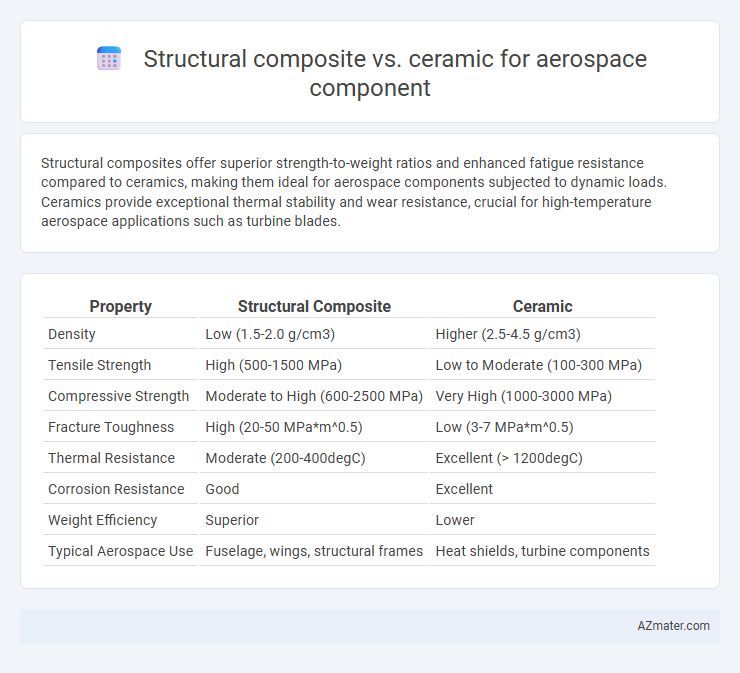Structural composites offer superior strength-to-weight ratios and enhanced fatigue resistance compared to ceramics, making them ideal for aerospace components subjected to dynamic loads. Ceramics provide exceptional thermal stability and wear resistance, crucial for high-temperature aerospace applications such as turbine blades.
Table of Comparison
| Property | Structural Composite | Ceramic |
|---|---|---|
| Density | Low (1.5-2.0 g/cm3) | Higher (2.5-4.5 g/cm3) |
| Tensile Strength | High (500-1500 MPa) | Low to Moderate (100-300 MPa) |
| Compressive Strength | Moderate to High (600-2500 MPa) | Very High (1000-3000 MPa) |
| Fracture Toughness | High (20-50 MPa*m^0.5) | Low (3-7 MPa*m^0.5) |
| Thermal Resistance | Moderate (200-400degC) | Excellent (> 1200degC) |
| Corrosion Resistance | Good | Excellent |
| Weight Efficiency | Superior | Lower |
| Typical Aerospace Use | Fuselage, wings, structural frames | Heat shields, turbine components |
Introduction to Aerospace Material Selection
Structural composites and ceramics offer distinct advantages for aerospace component design, with composites providing high strength-to-weight ratios and excellent fatigue resistance, while ceramics excel in high-temperature stability and corrosion resistance. Aerospace material selection prioritizes factors such as mechanical performance, thermal properties, weight reduction, and environmental durability to optimize fuel efficiency and structural integrity. Advanced composites like carbon fiber reinforced polymers and ceramic matrix composites are increasingly integrated to balance performance requirements in demanding aerospace applications.
Overview of Structural Composites
Structural composites in aerospace consist primarily of fiber-reinforced polymers, combining high-strength fibers such as carbon or glass with lightweight polymer matrices to achieve superior strength-to-weight ratios. These composites offer excellent fatigue resistance, corrosion resistance, and design flexibility, making them ideal for primary airframe and engine components. Their inherent damage tolerance contrasts with brittle ceramics, enabling better performance under dynamic load conditions common in aerospace environments.
Key Properties of Ceramic Materials
Ceramic materials used in aerospace components exhibit exceptional thermal resistance, with melting points often exceeding 2000degC, making them ideal for high-temperature environments such as turbine blades and heat shields. Their high hardness and wear resistance contribute to durability under mechanical stress, while low density enhances fuel efficiency by reducing overall component weight. Despite brittleness, advanced ceramics offer excellent chemical stability and oxidation resistance, crucial for long-term performance in harsh aerospace conditions.
Strength-to-Weight Comparison
Structural composites exhibit an exceptional strength-to-weight ratio, often surpassing traditional ceramics used in aerospace components by providing high tensile strength alongside low density. Ceramics offer superior hardness and temperature resistance but generally suffer from brittleness and lower fracture toughness, limiting their load-bearing capacity under dynamic stresses. Advances in fiber-reinforced composites enhance toughness and fatigue resistance, making them more suitable than ceramics for critical aerospace load-bearing parts where lightweight and durability are essential.
Thermal Resistance and Performance
Structural composites exhibit excellent thermal resistance due to their low thermal conductivity and high strength-to-weight ratio, enabling aerospace components to maintain integrity under fluctuating temperatures. Ceramics offer superior thermal stability and can withstand extreme temperatures exceeding 1600degC, making them ideal for high-temperature engine parts and thermal barrier coatings. The choice between structural composites and ceramics depends on specific performance requirements such as weight constraints, thermal tolerance, and mechanical stress resistance in aerospace applications.
Durability and Fatigue Life
Structural composites exhibit superior fatigue life due to their ability to absorb and dissipate energy through fiber-matrix interactions, reducing crack initiation and propagation in aerospace components. Ceramics, while highly durable under compressive loads and resistant to high temperatures, tend to be brittle and prone to catastrophic failure under tensile stress and cyclic loading. Therefore, structural composites are generally preferred in aerospace applications requiring enhanced durability and extended fatigue life, especially in dynamic environments.
Manufacturing and Cost Implications
Structural composites in aerospace manufacturing offer high strength-to-weight ratios and reduced fabrication complexity compared to ceramics, which demand energy-intensive sintering and machining processes. Composite materials enable cost-effective mass production through automated layup and curing techniques, whereas ceramics involve expensive raw materials and longer cycle times, increasing overall expenses. The integration of composites leads to lower lifecycle costs and enhanced design flexibility, while ceramic components, although superior in thermal resistance, incur higher initial manufacturing investments.
Applications in Modern Aerospace Components
Structural composites, such as carbon fiber-reinforced polymers, dominate aerospace applications due to their high strength-to-weight ratio and corrosion resistance, enabling lighter airframes and improved fuel efficiency. Ceramics are primarily used in engine components and thermal protection systems because of their exceptional heat resistance and wear properties, critical for turbine blades and heat shields. The integration of composites in fuselage and wing structures complements ceramics in high-temperature zones, optimizing overall aircraft performance and durability.
Environmental Impact and Sustainability
Structural composites in aerospace offer significant weight reduction, leading to lower fuel consumption and reduced carbon emissions throughout the aircraft's lifecycle. Ceramic materials provide excellent thermal resistance and durability, extending component lifespan and reducing maintenance frequency, which can minimize resource use and environmental waste. Sustainable aerospace design increasingly favors composites due to their recyclability advancements, though ceramics contribute to eco-efficiency by enhancing component longevity and performance in high-temperature environments.
Future Trends in Aerospace Material Innovation
Structural composites offer lightweight strength and fatigue resistance, making them ideal for aerospace components demanding high performance and fuel efficiency. Ceramic materials provide exceptional thermal stability and oxidation resistance, critical for engine parts exposed to extreme temperatures. Future trends emphasize hybrid composites that integrate ceramic nanomaterials to enhance mechanical properties and thermal durability, driving innovations in next-generation aerospace materials.

Infographic: Structural composite vs Ceramic for Aerospace component
 azmater.com
azmater.com